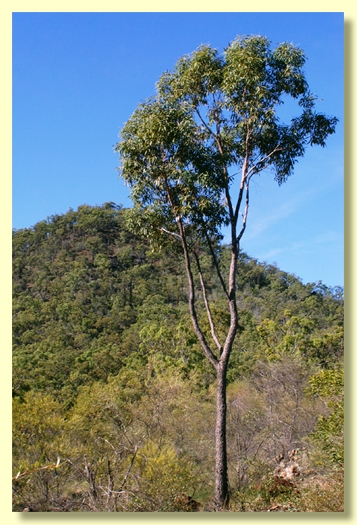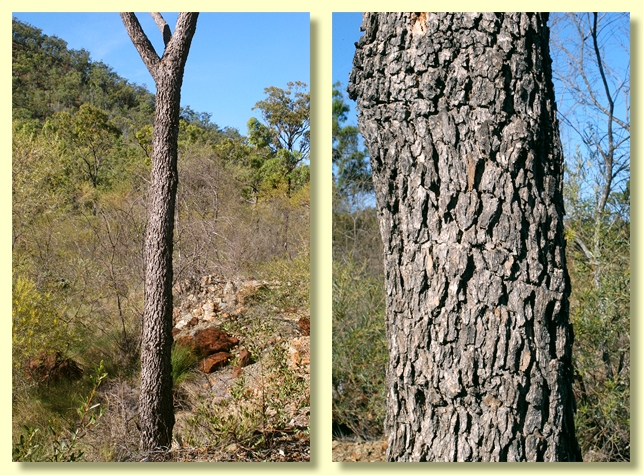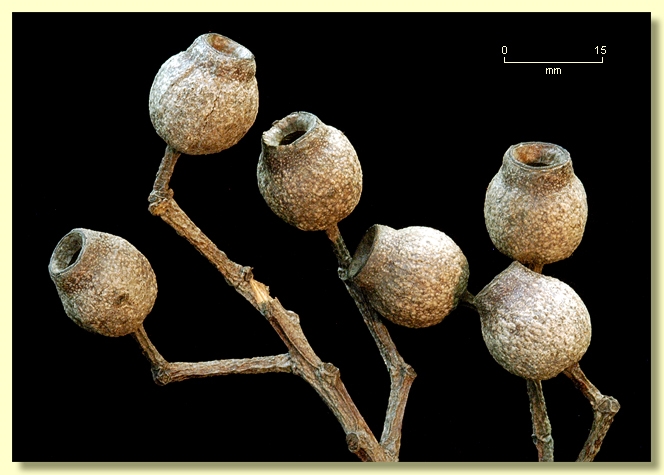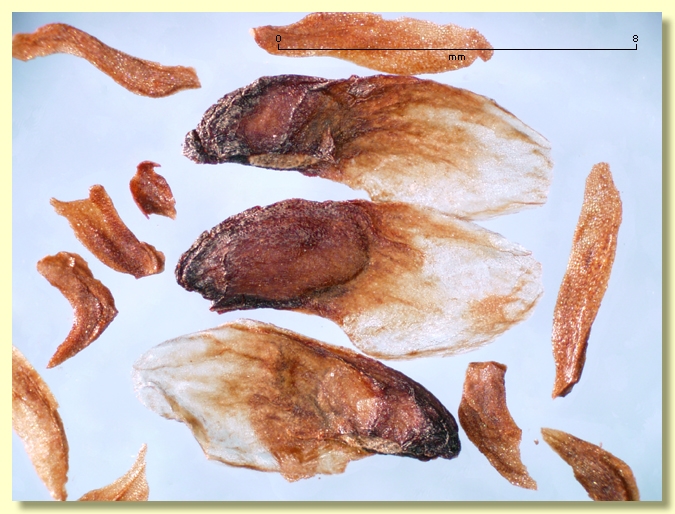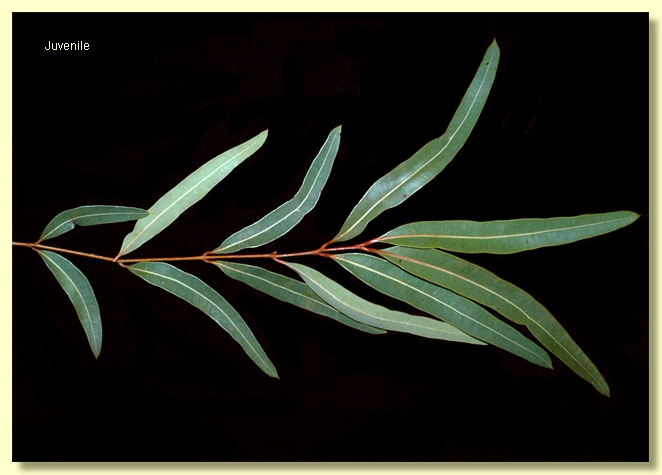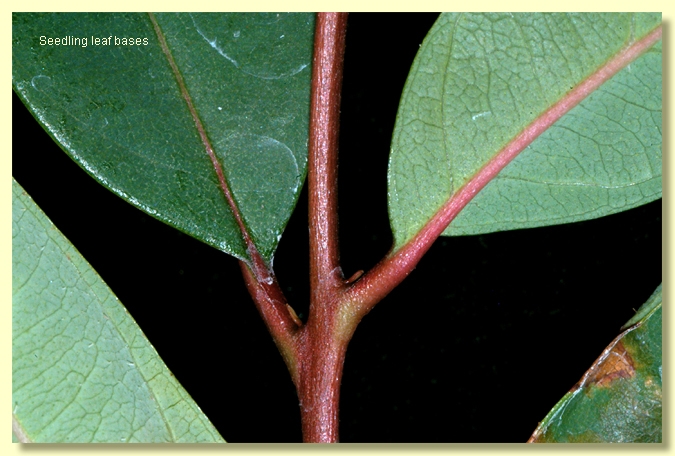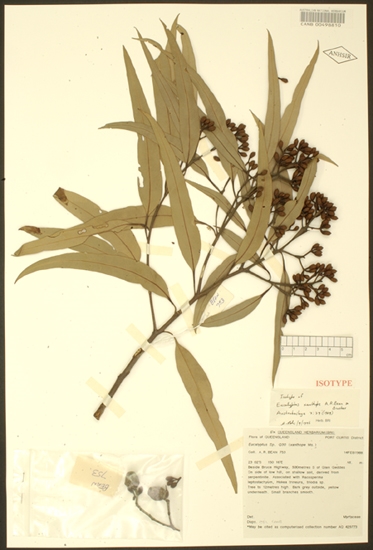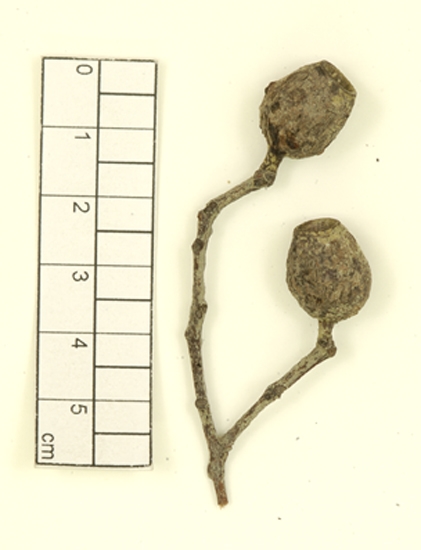Euclid - Online edition
Corymbia xanthope
Corymbia | Rufaria
Corymbia xanthope (A.R.Bean & Brooker) K.D.Hill & L.A.S.Johnson, Telopea 6: 277 (1995).
Eucalyptus xanthope A.R.Bean & Brooker, Austrobaileya 3: 39 (1989). T: Queensland: Port Curtis District: Bruce Highway, 0.5 km south of Glen Geddes Siding, 23°02'S, 150°16'E, 14 Feb. 1988, A.R.Bean 753; holo: BRI; iso: CANB, NSW.
Tree to 12 m tall. Forming a lignotuber.
Bark rough over trunk and branches to ca 3 cm diameter, hard, thick, corky and tessellated, outer bark greyish with yellow to pinkish brown underbark visible.
Branchlets smooth (glabrous); long oil bodies sometimes visible in the pith.
Juvenile growth (coppice or field seedlings to 50 cm): stems rounded in cross-section, smooth or slightly scabrid only on the lowest part; juvenile leaves always shortly petiolate (occasional leaf sessile), opposite for many nodes or becoming sub-opposite, linear-elliptic to narrowly lanceolate, 4.8–10 cm long, 0.7–2 cm wide, base tapering to petiole, apex pointed, green, discolorous, glabrous.
Adult leaves alternate, petioles 0.8–2.2 cm long; blade lanceolate to falcate, 9–20 cm long, 1–2.5 cm wide, base tapering to petiole, margin entire, apex finely pointed, strongly discolorous, glossy and dark green above, paler below, smooth, side-veins at greater than 45° to midrib, reticulation dense to very dense, intramarginal vein present but very close to margin (more easily seen from underside when dry), oil glands obscure or sparse, island.
Inflorescence terminal compound, peduncles slender 0.6–1.6 cm long, buds 7 per umbel, pedicels 0.3–1.1 cm long. Mature buds obovoid to ± cylindrical, 0.7–0.8 cm long, 0.4–0.5 cm wide, scar absent (both opercula shed together at flowering), operculum rounded to conical, stamens inflexed, all fertile, anthers oblong, dorsifixed, versatile, dehiscing by longitudinal slits, style long and straight, stigma blunt and shortly papillose, locules 3 or 4, the ovules not arranged in clear rows on the placentae (sometimes 5 rows ± discernable). Flowers creamy white.
Fruit pedicellate (pedicels 0.2–0.9 cm long), urceolate with short neck not flared at rim, 1.4–2 cm long, 1–1.5 cm wide, longer than wide, ± smooth, disc descending vertically, valves 3 or 4, enclosed.
Seeds brown, 7–11 mm long, ellipsoidal with terminal wing, hilum ventral
Cultivated seedlings (measured at ca node 10): cotyledons large, reniform; stems rounded in cross-section, setose with short bristle-glands for about lowest 3–7 nodes, then glabrous; leaves shortly petiolate (petioles to 0.7 cm), opposite for at least 16 nodes, linear-lanceolate, 5–11 cm long, 1–2.5 cm wide, base tapering to petiole, light to mid green, discolorous, setose on lower leaves, becoming free of setae by ca node 3–8, upper surface slightly glossy by node 9.
Flowering time not known.
A bloodwood tree endemic to central-coastal Queensland north of Rockhampton, where found on rising ground, on shallow red-brown clay, clay loam and sandy loam soil developed over serpentinite rock, and apparently restricted to this substrate. Found in the Marlborough, Glen Geddes, Yaamba and Mount Redcliffe areas and also on South Percy Island, on small rocky hills and gentle slopes. Corymbia xanthope is fully rough-barked with grey over yellowish and pinkish brown tessellated bark and a crown of glossy green discolorous leaves darker on the upper side, paler below, and compound inflorescences terminal to the branchlets. Buds are smooth-surfaced and the fruit urceolate. Juvenile leaves are linear-elliptic (4.8–10 cm long, 0.7–2 cm wide) and glabrous.
C. xanthope is closely related to the more inland dwelling C. hendersonii and differs from that species only on the smaller fruits (1–1.5 cm wide in C. xanthope cf. (1.2)1.4–2.1 cm wide in C. hendersonii), and yellowish brown bark.
In its narrow coastal range C. xanthope is likely to be confused with C. intermedia, as both have smooth buds, discolorous adult leaves and rough tessellated bark. The outermost branches of C. xanthope tend to be smooth-barked (rough in C. intermedia), whilst the bark on the trunk tends to have yellowish underbark (grey-brown underbark in C. intermedia), and juvenile leaves of C. xanthope are narrower than those of C. intermedia (2–4.2 cm wide in the latter).
The only other bloodwood with discolorous leaves and rough bark likely to be confused with C. xanthope is C. clarksoniana which differs most noticeably in always having scurfy buds and often broader juvenile leaves (1.2–5 cm wide).
Corymbia xanthope is listed (as Eucalyptus xanthope), as "Vulnerable" under the Australian Government Environment Protection and Biodiversity Conservation Act 1999 (EPBC Act). Further information may be found at this web address:
http://www.environment.gov.au/cgi-bin/sprat/public/sprat.pl
MORE ABOUT CORYMBIA
MORE ABOUT RED BLOODWOODS
Corymbia xanthope: Greek xanthos, yellow and ope, hole, referring to the yellowish underbark visible through gaps in the greyish outer bark.

